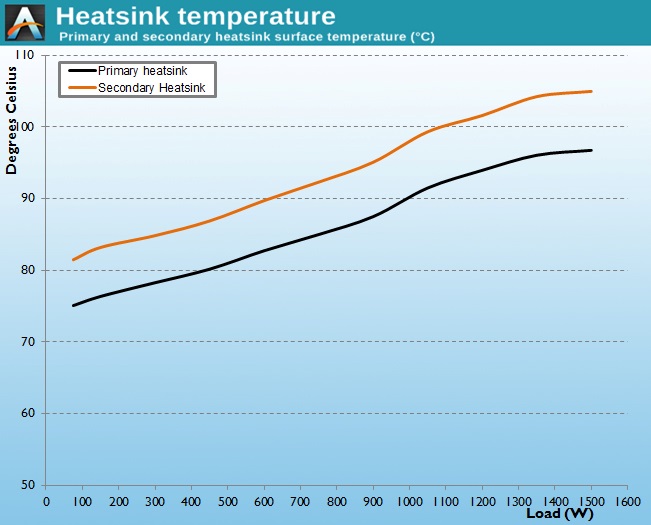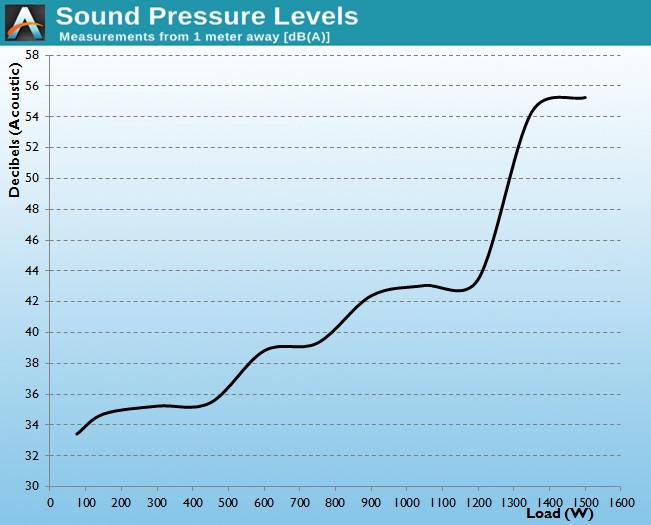The SilverStone Strider Gold S 1500W PSU Review
by E. Fylladitakis on April 7, 2015 8:00 AM EST- Posted in
- Cases/Cooling/PSUs
- PSUs
- SilverStone
- 1500W
Hot Test Results
As it can be seen in the following tables, SilverStone's currently most powerful PSU does offer outstanding power quality, especially if the massive power output is taken into account. The maximum voltage ripple on the 12V line is just 30mV at maximum load, under an outrageous current draw of nearly 110A. Ripple suppression is equally great on the minor voltage lines as well. Voltage regulation is a little more complicated, as the stability of the 12V line is amazing, with a change of less than 1% across the load range. However, the regulation of the 3.3V/5V lines is a lot less tight, at 2%/2.4% respectively.
| Main Output | ||||||||
| Load (Watts) | 303.02 W | 755.8 W | 1127.97 W | 1498.98 W | ||||
| Load (Percent) | 20.2% | 50.39% | 75.2% | 99.93% | ||||
| Line | Amperes | Volts | Amperes | Volts | Amperes | Volts | Amperes | Volts |
| 3.3 V | 4.55 | 3.39 | 11.38 | 3.38 | 17.07 | 3.34 | 22.76 | 3.33 |
| 5 V | 4.55 | 5.15 | 11.38 | 5.14 | 17.07 | 5.04 | 22.76 | 5.02 |
| 12 V | 21.85 | 12.09 | 54.63 | 12.06 | 81.94 | 12.02 | 109.26 | 11.98 |
| Voltage Ripple (mV) | |||||||
| Line | Regulation (20% to 100% load) |
||||||
| 20% Load |
50% Load |
75% Load |
100% Load |
CL1 12V |
CL2 3.3V + 5V |
||
| 3.3V | 2% | 6 | 8 | 14 | 20 | 10 | 26 |
| 5V | 2.4% | 6 | 10 | 16 | 24 | 10 | 30 |
| 12V | 0.9% | 8 | 16 | 22 | 30 | 34 | 16 |
Once again, we need to mention that this is a PSU rated at 40°C and we perform our testing at temperatures higher than 45°C - we could reduce the ambient temperature of our hotbox testing but we chose not to do so as the results would then not be comparable to those of our previous reviews.
According to these results, it becomes apparent that SilverStone is most likely just playing it safe regarding the 40°C rating for continuous operation. High ambient temperatures had little effect on the performance of the ST1500-GS, reducing its energy conversion efficiency by an average of just 0.3%. The maximum efficiency is reduced to 91.6% at exactly half load.
High temperatures are to be expected from a PSU with this kind of power output and the ST1500-GS does get terribly warm when fully loaded under these conditions. Do note however that the probe that is taking our secondary side readings is now sandwiched between the thermal pad and the chassis (that acts as the main secondary side heatsink), meaning that the readings are naturally higher than with other models. The cooling fan once again follows a "stepping" speed model - the only difference is that now the fan jumps up to maximum RPM at 90% load, correctly abandoning every notion of acoustic comfort to ensure reliability.















32 Comments
View All Comments
Gigaplex - Tuesday, April 7, 2015 - link
reininop: "the efficiency of these usually peaks at about 50 - 70% of rated power"DanNeely: "You obviously didn't read much if any of the article: You're way off..[snip].. and peaked at 92% efficient at a 50% load."
I'd say reininop was spot on. They were stating that efficiency is at its best at 50%-70% load, not that the PSU is 50%-70% efficient.
reininop - Wednesday, April 8, 2015 - link
You know, I typically read the intro and the final words and then if I find it interesting I go back and read the rest. In this case, I read some of the comments first as well. I have since went back and saw your power efficiency graph. I felt the comment was meant to be taking as a bit of a joke as I was pointing out a user case that almost certainly doesn't exist. For some reason, you seemed to take personal offense to it.As for the rest of you comment, I am well aware of what the 80+ gold means. I never said anything about the conversion efficiency, only the peak rate of efficiency as a function of the output power. Hence, when I said tech enthusiast, I was attempting to imply someone who actually has components that require 750 W to operate. I assume the confusion arose from my use of the word "pull" when discussing the actual system power requirements and you assumed I meant the outlet power.
KAlmquist - Wednesday, April 8, 2015 - link
The problem for the eco-conscious tech enthusiast is that the efficiency of this power supply drops significantly when power consumption falls below 300 watts. So it may be efficient during heavy gaming, but not so much when you take a break to post comments on anandtech.com.wbwb - Wednesday, April 8, 2015 - link
On the other hand, at idle load, an improvement in efficiency can make a difference of only a few watts, so it's understandable that the focus of 80plus has been on efficiency at higher loads where a little improvement can make a big difference. That was the low-hanging fruit. With that taken care of, they should now be improving the low end.Poik - Tuesday, April 7, 2015 - link
I'd just like to point out that anything above a 1440W PSU (assuming that's what they're pulling off the "mains") should really be on a 20A breaker/circuit. I know that 20A circuits are very common in the US - but they're far less common in Canada.The reason for this is that in both Canada and the US (and Europe too?) the normal household breakers are only rated to sustain 80% of their rated capacity. Ergo a 15A breaker will only hold 12A and a 20A breaker will hold 16A. Respectively those are good for 1440W and 1920W.
It's good to see the C19 plug being used here as that should force people to use a 20A T-slot plug (15/20A Hybrid) that should be common in the US. It seems very few people are aware of this but it's an important consideration - especially if you plan on using this PSU to its full potential.
Gigaplex - Tuesday, April 7, 2015 - link
Or, like the bulk of the rest of the world, it should run at ~240V.Pissedoffyouth - Wednesday, April 8, 2015 - link
Hmm really puts in perspective how lucky we are to have 240v in rest of worldex_User - Wednesday, April 8, 2015 - link
Consumer-grade 1500W PSU in year 2015? Buying one should be a freaking criminal offense -- together with multi-GPU setups and such. Really, people, wake the frack up!Oxford Guy - Thursday, April 9, 2015 - link
Criminal offense? How about asking people who just dropped 800 or more dollars on monitors (which you can still buy today) to replace them because the manufacturer isn't going to bother updating its firmware to support Freesync?ZeliaS - Wednesday, April 8, 2015 - link
Throwing this out there, I've owned a SilverStone Zeus 850W PSU for more than 8 years now... Switched 4 PC configurations on it. There were periods of more than 2 years without cleaning it. About an year ago I measured it extensively, I literally had to bend down in an efford to hear the fan, and all I have to say about my (first) experience with the brand is rounded up in one word - immaculate.